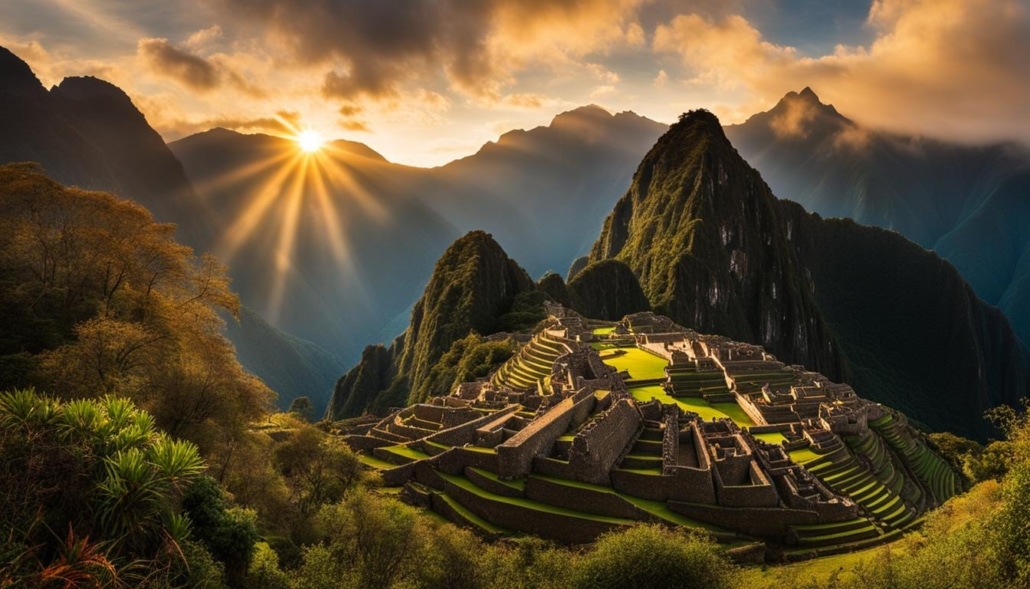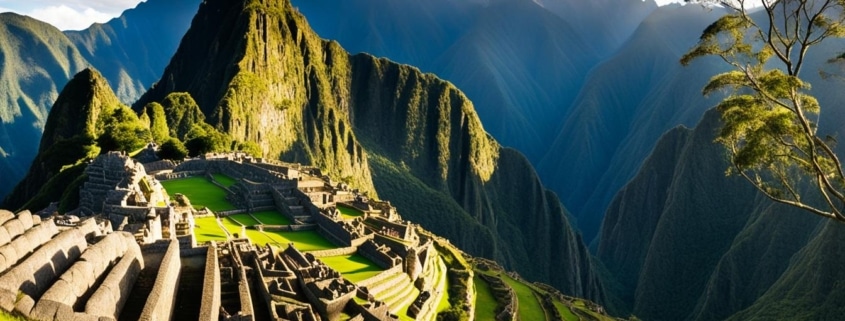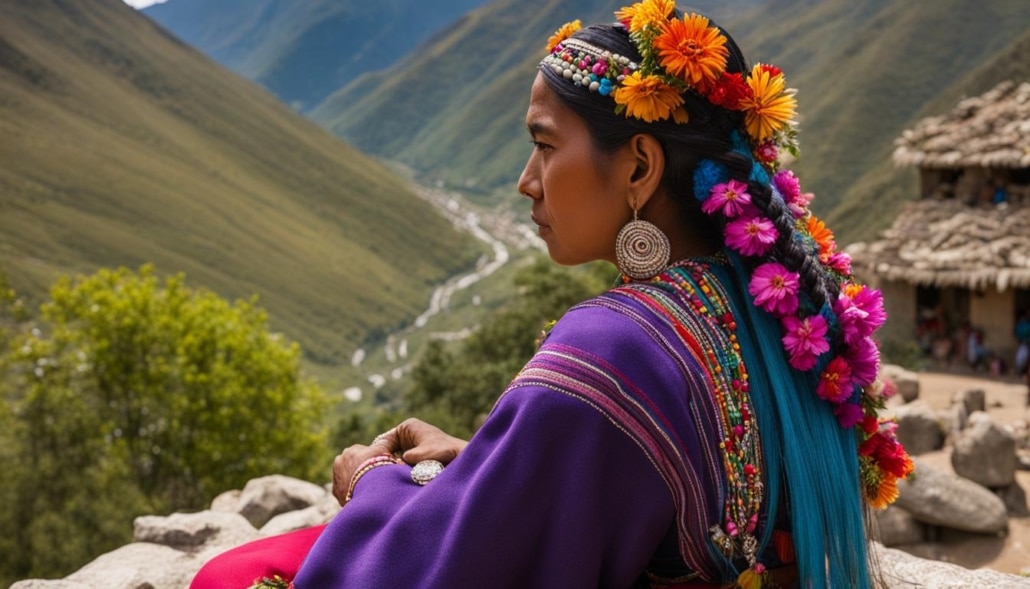Unveiling the Mysteries of Machu Picchu, Peru
Prepare to embark on a captivating journey through time as we delve into the ancient ruins of Machu Picchu in Peru. This awe-inspiring UNESCO World Heritage Site holds immense cultural and historical significance, and its mysteries continue to fascinate explorers and historians alike. Let’s explore the secrets of this remarkable city and unravel the enigma that is Machu Picchu.
With its rich history and breathtaking beauty, Machu Picchu stands as a testament to the ingenuity and artistic excellence of the Inca civilization. Hidden among the dramatic Andean peaks, this ancient wonder is believed to have been a royal retreat or country palace for the Inca emperor, Pachacuti. However, the purpose and significance of this extraordinary site are still subjects of debate and speculation.
Join us as we embark on a virtual journey to uncover the secrets of Machu Picchu. From its discovery by Hiram Bingham in 1911 to its architectural marvels and cultural significance, we will provide you with a comprehensive insight into this mystical place. Get ready to explore the wonders of Machu Picchu and immerse yourself in its centuries-old aura.
The Discovery of Machu Picchu
Machu Picchu, an awe-inspiring lost city nestled in the Andes Mountains of Peru, remained hidden from the world until its rediscovery by Hiram Bingham in 1911. Bingham, a prominent American explorer and archaeologist, was determined to unravel the mysteries of the Inca civilization and embarked on an expedition to find lost Inca sites in the region.
During his explorations, Bingham stumbled upon the remarkable Inca ruins of Machu Picchu. He was astounded by the well-preserved state of the city, untouched by modern civilization, and recognized its immense historical and cultural importance. With his groundbreaking discovery, Bingham played a pivotal role in bringing Machu Picchu to the international spotlight.
“Machu Picchu is a place where the present and the past exist side by side, a testament to the incredible achievements of the Inca civilization,” said Bingham, marveling at the impressive ruins he had discovered.
The exploration and subsequent documentation of Machu Picchu by Hiram Bingham provided invaluable insights into the lives and achievements of the ancient Incas. It revealed a lost city that had remained hidden for centuries, shrouded in the mists of time. Bingham’s findings sparked immense curiosity and fascination among scholars, historians, and travelers alike.
Today, Machu Picchu stands as a testament to the rich cultural heritage of the Inca civilization and attracts millions of visitors from around the world. Its grandeur, architectural marvels, and breathtaking views continue to captivate and inspire all who have the opportunity to experience this extraordinary site firsthand.
The Architecture and Design of Machu Picchu
The layout and architecture of Machu Picchu showcase the Inca civilization’s extraordinary engineering skills. The city was meticulously designed to incorporate celestial alignment, displaying the Inca’s deep reverence for nature and the cosmos.
The structures within Machu Picchu, such as the Temple of the Sun and the Intihuatana Stone, are prime examples of the Inca’s architectural prowess and the spiritual significance of the site. The intricate stonework and precise construction techniques employed by the Inca engineers continue to awe and inspire visitors.
“The grandeur of the architectural marvels at Machu Picchu is a testament to the Inca’s mastery of engineering and their deep connection to the celestial realm.”
Each element of the city’s design, from its strategic location on a mountain ridge to the precise positioning of buildings and terraces, reflects the Inca’s meticulous attention to detail and their intimate understanding of celestial alignments. This celestial alignment allowed the Inca to observe and celebrate important astronomical events, such as solstices and equinoxes.
Architectural Marvels of Machu Picchu
The architectural marvels of Machu Picchu extend beyond its grand scale and celestial alignment. The intricate stonework, characterized by perfectly cut and interlocking stones, showcases the Inca’s mastery of construction techniques without the use of mortar. The precision with which the stones fit together is a testament to their ingenious engineering practices.
Machu Picchu is also known for its advanced water management system, featuring a series of channels and fountains that provided the site with a reliable water supply. The integration of this system into the city’s design demonstrates the Inca’s emphasis on practicality and sustainability.
| Architectural Features | Description |
|---|---|
| Terraces | The terraces at Machu Picchu served both agricultural and architectural purposes. They prevented erosion and provided flat surfaces for construction. |
| Intihuatana Stone | Believed to be an astronomical clock or calendar, the Intihuatana Stone symbolized the Inca’s connection to the divine. |
| Temple of the Sun | A sacred site dedicated to Inti, the Inca sun god. Its location and design were carefully chosen to align with the movement of the sun during solstices and equinoxes. |
Exploring the Cultural Significance of Machu Picchu
Machu Picchu, with its breathtaking beauty and ancient ruins, holds immense cultural significance for the indigenous people of Peru. It represents the indomitable spirit, ingenuity, and wisdom of their ancestors, serving as a symbol of pride and identity. The site’s spiritual aura draws in visitors seeking a deeper connection with the past and a chance to experience the profound spirituality of the Inca civilization.
Visiting Machu Picchu offers a unique opportunity to engage with local communities and learn about their vibrant indigenous culture. Interacting with the locals allows you to immerse yourself in the rich tapestry of Inca traditions, passed down through generations. From traditional weaving techniques to ancient cooking practices, you can witness the living heritage of the indigenous people firsthand.
“The cultural legacy of Machu Picchu is a testament to the resilience and creativity of the Inca civilization. Exploring the site provides a profound understanding of their values and way of life.” – Local guide, Juanita Morales
As you wander through the ancient pathways of Machu Picchu, you’ll encounter spiritual rituals still practiced by the descendants of the Inca. These rituals, performed with reverence and respect, offer a glimpse into the profound spirituality that underlies every stone and corner of the site. The spiritual aura of Machu Picchu inspires introspection, reflection, and a sense of awe for the wonders of the natural world.
Traditional Practices and Cultural Exchanges
To fully appreciate the cultural significance of Machu Picchu, consider participating in community-based tourism initiatives. These initiatives provide an opportunity to contribute to the sustainable development of local communities while learning about their ancestral knowledge and way of life. Through homestays, traditional ceremonies, and cultural exchanges, you can foster a deeper connection with the place and its people.
By supporting indigenous artisans and purchasing their handmade crafts, such as textiles and pottery, you contribute to the preservation of their cultural heritage. The intricate designs and vibrant colors in these crafts reflect the deep-rooted traditions and artistic expressions of the Inca civilization.
Preserving Indigenous Culture and Heritage
Preserving the indigenous culture and heritage of Machu Picchu is essential for future generations. Sustainable tourism practices, such as responsible trekking and eco-conscious accommodation, help protect the fragile ecosystem of the site. Respect for local customs, traditions, and sacred spaces plays a vital role in honoring the cultural significance of Machu Picchu and ensuring its preservation for years to come.
| Key Aspects of Indigenous Culture at Machu Picchu | Impact on Visitors |
|---|---|
| Ancient rituals and spiritual practices | Provides a deeper understanding of Inca spirituality and connection to the natural world |
| Community-based tourism initiatives | Offers an opportunity to engage with local communities and contribute to their sustainable development |
| Traditional crafts and arts | Preserves indigenous cultural heritage and supports local artisans |
| Sustainable tourism practices | Ensures the preservation of the site’s fragile ecosystem and indigenous culture |
Experiencing Machu Picchu: Tips and Travel
To make the most of a visit to Machu Picchu, planning well is essential. This UNESCO World Heritage Site offers a plethora of unforgettable experiences, from trekking routes that weave through breathtaking landscapes to witnessing awe-inspiring sunrise views. Additionally, practicing sustainable tourism is crucial to preserving the site’s fragile ecosystem and ensuring its longevity.
Trekking Routes to Machu Picchu
Embarking on one of the iconic trekking routes, such as the renowned Inca Trail, is an immersive way to connect with the ancient allure of Machu Picchu. These routes, carved into the Peruvian Andes, provide an extraordinary opportunity to traverse picturesque landscapes, encounter fascinating ruins, and unravel the mysteries of the Inca civilization.
During the treks, hikers can explore magnificent mountain ranges, lush cloud forests, and charming Andean villages. The journey culminates in the grand finale of reaching Machu Picchu, where the stunning views and sense of accomplishment make every step worthwhile.
Marvelous Sunrise Views
Witnessing the sunrise over Machu Picchu is a truly magical experience. As the first rays of sunlight illuminate the ancient citadel, it is as if time stands still and the beauty of the surroundings is intensified. The changing hues of the landscape, the mystical mist hugging the mountains, and the iconic Machu Picchu itself create an unforgettable moment that will forever be etched in memory.
There are various vantage points from which to admire the sunrise at Machu Picchu, each offering a unique perspective. Whether it’s the Sun Gate (Inti Punku) or the Inca Bridge, visitors are guaranteed to be captivated by the ethereal beauty that unfolds before their eyes.
Practicing Sustainable Tourism
Machu Picchu is not only a historical wonder but also a fragile ecosystem that requires utmost care and preservation. As a responsible traveler, it is important to practice sustainable tourism to minimize the impact on the environment and local communities.
Respecting the rules and regulations set by the authorities is paramount. This includes staying on designated paths, not littering, and not touching or climbing on the ancient structures. Hiring knowledgeable guides ensures a deeper understanding of the site’s significance and helps support local communities.
Adapting to the high altitude is imperative for a safe and enjoyable visit. Acclimatizing in Cusco or the Sacred Valley beforehand and staying hydrated throughout the journey are key steps towards preventing altitude sickness.

Exploring Machu Picchu is a transcendent experience, filled with wonder, history, and natural beauty. By following these tips and embracing sustainable tourism practices, visitors can not only enjoy the treasures of Machu Picchu but also contribute to its preservation for future generations to come.
Conclusion
Machu Picchu, the ancient wonder nestled amidst the Peruvian Andes, stands as a testament to the ingenuity and artistic excellence of the Inca civilization. Its allure knows no bounds, captivating travelers from around the world and granting them an unparalleled opportunity to delve into the mysteries of the past.
Exploring the majestic ruins of Machu Picchu is a transformative experience that allows visitors to immerse themselves in the rich history, cultural significance, and awe-inspiring beauty of this remarkable site. As one wanders through the ancient streets and marvels at the precision of Inca engineering, it becomes clear that this city was far more than just a physical structure; it was a testament to the greatness of a civilization that thrived in harmony with its natural surroundings.
Stepping foot in Machu Picchu, one cannot help but feel a profound connection to the past and an appreciation for the achievements of the Inca people. The site’s grandeur and spiritual aura continue to inspire and leave a lasting impact on all who have the privilege to visit. Machu Picchu truly is a timeless wonder that invites us to reflect on the wonders of the human spirit and the enduring legacy of the Inca civilization.
FAQ
What is the significance of Machu Picchu?
Machu Picchu holds immense cultural and historical significance for Peru and the indigenous people. It represents the ingenuity and wisdom of their ancestors and is considered a symbol of pride and identity.
Who discovered Machu Picchu?
Machu Picchu was discovered by Hiram Bingham, an American explorer and archaeologist, in 1911.
What is the purpose of Machu Picchu?
The exact purpose of Machu Picchu is still debated, but it is believed to have served as a royal retreat or country palace for the Inca emperor, Pachacuti. Other theories include it being a military stronghold or religious sanctuary.
What can visitors expect to see at Machu Picchu?
Visitors can expect to see impressive Inca architecture, including structures like the Temple of the Sun and the Intihuatana Stone. They can also experience breathtaking views, learn about traditional practices from local communities, and feel a deep connection to the past.
How can I reach Machu Picchu?
There are various options for reaching Machu Picchu, including trekking routes like the Inca Trail. It is important to plan your trip well and consider factors like acclimatizing to the altitude, hiring knowledgeable guides, and practicing sustainable tourism.
Source Links
- https://carnegiemuseums.org/magazine-archive/2003/sepoct/feature1.html
- https://medium.com/@keremgulfidan/unveiling-the-mysteries-of-machu-picchu-a-comprehensive-guide-37a8010b1455
- https://medium.com/@masterioworld/discovering-the-mysteries-of-machu-picchu-unveiling-the-wonders-of-the-lost-city-of-the-incas-76340d66c01f





Leave a Reply
Want to join the discussion?Feel free to contribute!